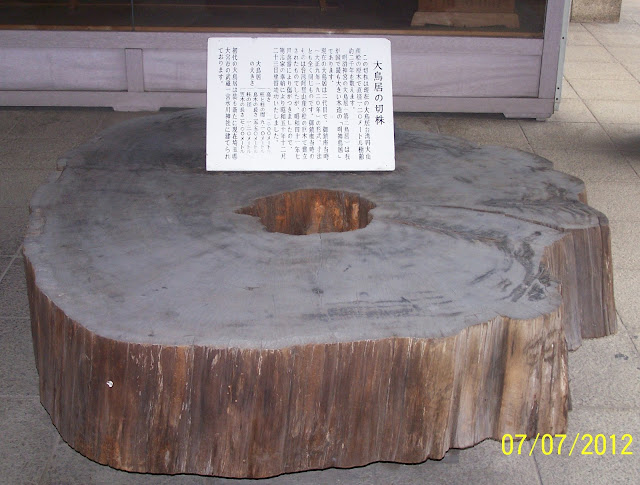1. Tanabata
Story: A young farmer named Mikeran discovered on his farm a robe which, unbeknownst to him, belonged to a goddess named Tanabata. Soon after, Tanabata visited Mikeran and asked if he had found it. He lied and told the goddess that he hadn't but would help with her search. Eventually the pair fell in love, were wed and had many children. However, one day Tanabata noticed a piece of cloth which had once belonged to her robe on the roof of Mikeran's hut. His lie discovered, Tanabata agreed to forgive him on the condition that he weave a thousand pairs of straw shoes, but until that time, she would leave him. Mikeran was unable to weave the shoes in his lifetime and thus never met Tanabata again. However, it is said that the pair meet once a year when the stars Altair and Vega intersect.
It is said that Tanabata asked Mikeran to weave one thousand sandals and bury them under the bamboo tree and they'd surely meet again. Mikeran wove the sandals and buried them under the bamboo tree as Tanabata had asked. When the tree grew, Mikeran climbed up to find that he was one step short. In his haste, he had used one sandal fewer than necessary, causing the tree to grow one step short. Mikeran called out to Tanabata and she came and lifted him up. Mikeran's father wasn't pleased so he gave Mikeran the difficult job of watching a melon field for three days and nights without touching a single melon. Mikeran however grew very thirsty watching the melons that he touched one. The melon immediately turned into a flowing river forever separating Mikeran and Tanabata. Tanabata pleaded with her father to let her see Mikeran again. Feeling sorry for his daughter, he allows them to see each other on the 7th day of the 7th month.
2. Meiji-jingu
Meiji-jingu is Tokyo's grandest shinto shrine. Apparently, the woods began from 100,000 trees from Japan and all around the world that were hand planted. The museum was a little boring because there was not a lot of English. The park was beautiful though and really peaceful. The shrines gates were gigantic.
What is Shinto?
Shinto is called Japan's ancient original religion and is deeply rooted in the way of Japanese life. Shinto has no founder, no holy book and not even the concept of religious conversions, but is made of Shinto values (for ex: harmony with nature) and virtues (such as "Magokoro" or sincere heart). In Shinto, some divinity is found as Kami (divine spirit), or it may be said that there is an unlimited number of Kami. You can see Kami in mythology, in nature and in human beings. From ancient times, Japanese people have felt awe and gratitude towards such Kami and dedicated shrines to many of them.
Meiji-jingu History: This shrine is dedicated to the divine souls of Emperor Meiji and his consort Empress Shoken. Emperor Meiji passed away in 1912 and Empress Shoken in 1914. Emperor Meiji is the 122nd emperor and the great-grandfather of the current emperor. He took the initiative to promote friendship with other countries and to introduce Western civilization and developed technology from overseas while preserving Japanese identity. He thus laid the foundations for modern Japan. Empress Shoken devoted herself to promoting national welfare and women's education. After their demise, the people wished to commemorate their virtues and venerate them forever. So they donated 100,000 trees from all over Japan and from overseas and they worked voluntarily to create this forest. The shrine was established on November 1, 1920.
For the times to come
And for meeting what must be met
All of our people
Must be taught to walk along
The path of sincerity.
Waka Poetry by Empress Shoken:
By making wider
The paths of deep friendships
We, without travel,
Have come to know the customs
Of lands throughout the world.

Saw a few weddings while we were there:
 |
| Horn hat (to cover a ladies horns so she's happy on her wedding day). |
 |
| Wedding and party. |


 |
| A round tuit. LOL. This one is for my parents. They'll understand. |
An alley that lies at the heart of Harajuku which embodies "teenage kitsch and subcultural fetish." It was raining today so it was really a see of umbrellas and was insanely full of people. So many people packed onto one tiny little street that was full of stores. Since it was raining we did not see a lot of your typical "harajuku kids". We stopped into a British style pub and had some beer and lunch. This was really the only time that we saw a few Japanese people getting rowdy. It was entertaining. From there we did a little shopping. I found one of my Korean actors on a keychain and then we stopped in a soccer shop where I bought a Japan jersey tee.


3. Condomania
We went to condomania because we thought it would be funny. Not at all what we expected. It wasn't much bigger than a walk-in closet, just hanging out on the street corner.
Also saw a protest while in Harajuku. The protest was against kicking the homeless out of the area. We
really only saw one or two homeless people and a few areas on the street where you could see their belongings. It was nothing like here. All of their belongings were nicely put in a pile and not very unsightly, as you would expect...
4. Setagaya Public Theatre: Akaji Maro's Virus
We got really lucky because this show was completely sold out except for nine standing room tickets. We got numbers 2 and 3 and were able to watch the performance. I can honestly say that I have never seen anything like it, and probably never will again. It was the strangest performance I have ever witnessed. Imagine strangely dressed dancers vibrating and humping on stage for over two hours. Akaji Maro came out twice during the performance: the first time wearing a long, white wig and dress, and the second time wearing a long, yellow wig and dress. He danced through some big metal shapes (star, square, circle) and humped a girl on stage. It was crazy. Yo and I were speechless for a few minutes after the show and desperately in need of a beer. I'm so glad we went though. It was truly an experience of a lifetime.
 |
| The Standing Ticket |
1. Memory of the Cambrian
2. The scenery of One
3. Bera Women
4. RNA's Strategy
5. FOX-P2
6. DNA's Remorse
7. Across the Phylum
8. Capturing the Sun
9. Rebellion of the Net
10. Memory of the Future
11. The Second Scenery
12. Hybrid
13. Denouement
Afterwards, we went to the Sangen-jaya station and had a beer and a good meal. Decided to call it a night and head back to Machida. Got back around 11p, six pack in tow. Drank a few and hung out with Greg.











No comments:
Post a Comment